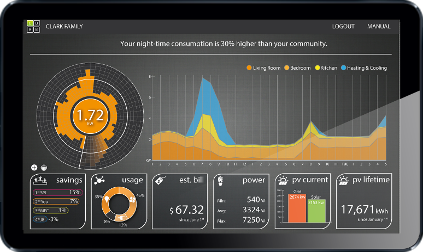 As consumers, inventions and new products can make us feel good about spending our hard-earned money on making our lives a little better. We feel even better when there is a story behind the product of small business success. But in the case of Curb Energy, this small business and product might change the way we look at our budgets.
As consumers, inventions and new products can make us feel good about spending our hard-earned money on making our lives a little better. We feel even better when there is a story behind the product of small business success. But in the case of Curb Energy, this small business and product might change the way we look at our budgets.
The Curb was invented a few years ago by Erik Norwood, a former rocket scientist, as a way for homeowners to figure out where their energy consumption is going. The Curb and the concept of circular energy tell a homeowner how much energy is being used in the home, from which sources, and at which times. In essence, they help a homeowner take command of his or her electricity use.
“We designed a company and a product which can be used by anybody who has an electricity bill,” says Norwood, founder and CEO of Curb Energy. “Essentially, the Curb can give you a breakdown of each appliance in your house and the amount of energy it uses.”
Norwood stated that in the process of people’s daily lives, “there needs to be more emphasis in cost about using power. Imagine going into a grocery store and buying food for which you did not get the bill until a month later.” Curb Energy is seeking to change that by allowing homeowners to regulate their power consumption.
The Curb attaches to a breaker box and communicates with the Curb Unit, watt by watt, the exact amount of energy that is being used by a source or outlet. The Curb connects to a software program that will immediately let a home consumer know what sources of energy are being used, when, and where.
Norwood has partnered up with Chuck McCarthy, a member of the original Atari team and the former CEO of ViewSonic. The company began as part of a small business accelerator called “Capital Factory” out of Austin, Texas. Norwood proudly announced that he had hired yet another staff member on the day of the interview. While the product itself is still in its infancy with a small number of installations, its potential is very exciting.
In essence, “knowing when to turn the switch off,” says McCarthy, is what saves people the costs of inefficient energy use. “Thinking about it might make you wonder what the budget really means,” says Norwood. “Nobody really knows where their energy is really going.” He further illustrated that “people would savor it more,” referring to the immediate feedback on energy consumption.
Originally designed for home applications, one-third of the boxes are now used in commercial applications. “The potential for employers to use this box and be able to pinpoint energy loss can mean significant contributions to the bottom line,” says Norwood. The unit is priced steeply at $350 for now, but it could end up saving consumers thousands of dollars in the long run.
Curb Energy has also been working with many electric vehicle organizations, which are well aware that consumers are curious as to how charging their car will affect their bill. The Curb is also a favorite of the alternative energy industry, as many solar energy firms are trying to help Curb market itself as a solar company and have developed partnerships with them. Recently, Curb has raised over $1.25 million in seed funding.
Norwood and McCarthy are steering their company in a direction with the belief that they feel will have open paths for them. Samsung is already hinting at an interest in Curb Energy. Moreover, as more homes are looking to automate things around the house, the market is picking up steam. The Curb does have a competitor, which designs a phone application with similar features, but with nowhere near the comprehensiveness and the accuracy of the Curb. Energy is “seeing a lot of traction,” states Norwood excitedly.
The product is being designed for home consumers and families. For decades, fathers have made a point that they are “not made of money” when the lights are left on. Now concrete in the form of a colorful and exciting application, this product can serve as proof and teach members of the family the value of energy efficiency. It could even lead the way to changing the way we think about energy.
Written by Paul Minassian.

Advertisement
Learn more about Electronic Products Magazine





